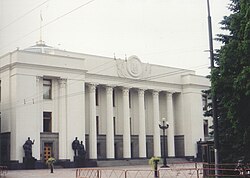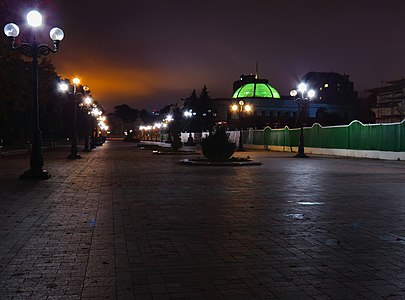Verkhovna Rada building
This article has multiple issues. Please help improve it or discuss these issues on the talk page. (Learn how and when to remove these template messages)
|
| Ukrainian Parliament Building Будинок Верховної Ради | |
|---|---|
 | |
 | |
| General information | |
| Architectural style | Ukrainian Classic |
| Location | Lypky district |
| Address | 5, Hrushevsky Street |
| Town or city | Kyiv |
| Country | Ukraine |
| Coordinates | 50°26′50″N 30°32′13″E / 50.44722°N 30.53694°E |
| Current tenants | Parliament of Ukraine |
| Construction started | 1936 |
| Completed | 1939 |
| Renovated | 1945–47 |
| Destroyed | World War II |
| Owner | State Bureau of Affairs |
| Height | 40 m |
| Dimensions | |
| Diameter | 16 m (plafond) |
| Technical details | |
| Floor count | 3 |
| Design and construction | |
| Architect(s) | Volodymyr Zabolotnyi |
| Awards and prizes | Architecture landmark |
| Website | |
| Google 3D Tour | |
The Verkhovna Rada building (Ukrainian: Будинок Верховної Ради, romanized: Budynok Verkhovnoi Rady) is located in the center of Kyiv, in the Pecherskyi District. The building is located at the Constitution Square.
It is the place where the Ukrainian
The building is located on the eastern side of
History
At the beginning of 1934, after the capital of the
In February 1936, a contest for the best building design of the Verkhovna Rada was announced. Numerous prominent specialists were invited, including Volodymyr Zabolotnyi, Valerian Rykov, and Yakiv Steinberg. The jury selected the design of Zabolotnyi. The construction was initiated in 1936 and lasted until 1939 with the final inspection taking place at the beginning of the summer, having the building passed with an excellent grade. The first session of the Verkhovna Rada took place at 5, Hrushevsky Street on 25 July 1939.
Main features
The building is designed in a strict rectangular-symmetrical form and is three floors high. It is crowned with a dome, made of metal and glass, providing the building with natural lighting. The hundred-tonne glass
The dome's multicolored illumination at night provides a memorable view, one of Kyiv's tourist attractions. The diameter of the
Post WWII reconstruction and 21st century decommunization
Having been destroyed in the
During the restoration works conducted in 1985 under the leadership of
This article needs attention from an expert in Architecture. See the talk page for details. (March 2011) |
The building's exterior is addressed in light colors through the use of light plaster and light-gray granite. These
Following 1991's
Gallery
-
Verkhovna Rada (right) Polyakova House (center) in 2013
-
Verkhovna Rada building at night in 2015
-
Verkhovna Rada building fromMykhaila Hrushevskoho Streetin 2013
-
Verkhovna Rada building in 2017
-
Protests at the Verkhovna Rada building in 2015
-
Verkhovna Rada building's gates in 2009 before Decommunization
Notes
- ^ Chmutina was one of several assistants of Zabolotny when his building design won the contest in 1936.
References
- ^ "Державна наукова архiтектурно-будiвельна бiблiотека iмені В.Г.Заболотного". 2017-03-19. Archived from the original on 2017-03-19. Retrieved 2023-02-10.
- Espreso.tv(23 August 2016)
External links
- "Photo Gallery of most famous places in Kyiv: Building of parliament". Archived from the original on September 6, 2006. Retrieved March 17, 2006.
- Mefford, Svitlana. "The Building of Verkhovna Rada. History of the sitting place of Ukrainian Parliament". The Ukrainian Observer (184). Archived from the original on January 14, 2016.
- "Verkhovna Rada Library: Verkhovna Rada building, Tour Overview" (in Ukrainian). Archived from the original on March 19, 2007. Retrieved March 21, 2006.
- "Ремонт примiщення Верховної Ради" (in Ukrainian). інформаційно-аналітичний тижневик "ПРОЯВ ТИЖНЯ". Archived from the original on February 21, 2005. Retrieved March 17, 2006.






